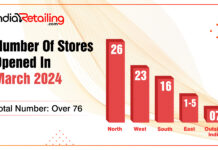According to research by Mckinsey, the top covid-era trend that is most likely to last is grocery e-commerce because of the simplicity and efficiency of online shopping and delivery.
By Punit Sindhwan
New Delhi: The Indian Online Grocery Market, which was worth $3.95 billion in FY2021, is anticipated to increase at a CAGR of about 33% during the forecast period 2017-2027 and would likely surpass $26.63 billion by FY2027, according to India Online Grocery Market report.
The main factors driving the growth of the Indian Online Grocery Market during the forecast period include shifting customer preferences, rising disposable income, new market entrants, increased focus on expanding e-commerce operations, and adoption of
attractive marketing methods.
One thing is certain given the exponential growth of online grocery shopping and delivery services: Customers want convenient access to their products. E-commerce for groceries is booming. Growth is also being stimulated by home delivery’s advancement.
According to research by McKinsey, the top COVID-era trend that is most likely to last a long time is grocery e-commerce. There are quite a few relevant reasons for this.
One is that people are generally concerned about their health and wellbeing. Some people would rather remain at home, despite the fact that societies are recovering from the COVID-19 pandemic. Others merely appreciate the variety of food that can be purchased online.
The supply chain issue is another aspect; ordering everyday consumption things online may be more convenient than doing so at your neighbourhood grocery store.
Going by the numbers
We must first comprehend the customer behaviour in order to better understand the growth of grocery e-commerce:
According to a survey by Grocery Dive, online grocery sales are expected to reach $129.72 billion by 2023.
- The Grocery Dive survey also revealed that 53% of consumers purchase groceries online because of the simplicity and efficiency of online shopping and delivery.
- The ability to maintain shopping lists (17%), save money (20%), and access a large assortment of products are further benefits of switching to online grocery shopping.
- The same study also claims that, at 47%, millennials are most likely to purchase groceries online. While only 4% of consumers from other generations, including 31% of Gen Xers and 19% of Baby Boomers, shop online.
Given the data on grocery e-commerce consumer behaviour and how dynamic and new this market is, let’s explore the difficulties it poses for online retailers.
Challenges faced by grocery e-commerce brands
Online grocery poses its own distinct challenges because it is so different from other businesses. Inventory varies frequently, margins are slim, and data disadvantages are common. Customers are also difficult to keep as loyal clients. However, there is a distinct set of answers for every distinct collection of problems:
Inventory Management: Inventory control is challenging due to the unpredictability of grocery availability. Out-of-stock products can damage a platform’s reputation, waste advertising costs, and create a bad customer experience that doesn’t result in sales because of the erratic nature of the E-grocery market.
Declining Margin: The margins in the grocery industry are already razor-thin, and many of them depend on shoppers picking up their purchases at the store and bringing them home on their own.
When sellers pick and deliver things themselves, grocery e-commerce raises the cost of both activities significantly. No matter how efficiently things are run, retailers are doing work that customers used to do for free, which is eroding operating margin and could perhaps cause it to completely collapse.
Revenue generating strategies for grocery e-commerce
Provide consumers with the information they want:
Enhance the information on your product detail page to
help customers make more informed judgments. They
include:
- Listing of food products with dietary advice
- Ingredients used in non-food products
- Using labels like “gluten-free” and “lactose-free” makes it simpler for customers to find products that satisfy their requirements.
These specifics will help customers see that you are available to help them. This fosters confidence despite brand changes.
Make sure that grocery shoppers can shop easily.
According to Statista, 79% of consumers believe that a company’s experiences are as significant as its products. Grocery companies require an accessible online presence. For instance, include recipes on your site so that visitors may choose the dishes they wish to make and then add a “bundle” of the necessary materials to their shopping carts. Recipes that solely
employ items that can be found in the neighbourhood store will be filtered out by adding ingredients based on store availability.
Emphasize the availability and selection of digital content:
It’s crucial for companies to comprehend the policies on how their items are shown because each store has its own rules about which products appear online.
It includes digital availability and selection, which requires:
- Examining and evaluating each retailer’s existing digital selection
- Evaluating the differences between the online and instore offers and putting both into practice
- Finding gaps and incremental seasonal possibilities to influence retailers’ online policies
- Supporting continuous maintenance and inspections
Combine online and offline experiences: Grocers should work on ways to offer customers as many benefits instore as they can, in addition to streamlining their online operations. Retailers must integrate in-store and online shopping experiences in order to synchronise their offline
and online business processes.
Customers who purchase online rely on websites and applications to determine whether the items they desire are available in stores. Grocery stores should place a higher priority on providing consumers with accurate information about what is actually available and replacement options when stock is limited.
In the end, grocery shopping is a structured, private activity that individuals feel they have some
kind of control over. It’s crucial to create a welcoming online shopping atmosphere that makes customers feel as though they are entering a physical store.
Utilize data analytics: A number of brands find it challenging to acquire visibility into the specifics
of their online sales figures, but it is worthwhile to make the effort to do so and to navigate the retailer specific complexities of extracting insights. The data is a goldmine of important information. Effective use of data and analytics can help identify issues with digital promotion and advertising as well as offer information on stock levels and out-of-stocks.
Final thoughts
E-commerce today demands increased organisational focus and effort in order to scale economically, as opposed to before the pandemic, when it made up 3 to 4 percent of overall sales. To narrow in on this market niche, grocers are expanding their e-commerce-focused category teams and examining stand-alone e-commerce financials. The future of e-commerce in the grocery sector in India is bright, so it’s time to accelerate growth for future profitability.








